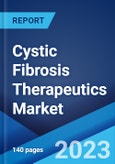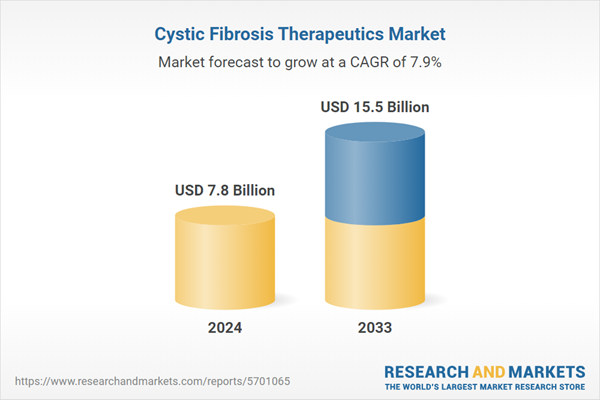Cystic fibrosis therapeutics enables management of the symptoms of a genetic disease affecting the respiratory and digestive systems. It encompasses a range of drugs, including CFTR modulators and gene therapy, offering tailored treatment options. It helps correct the underlying genetic defect responsible for CF by enhancing the function of the CFTR protein. It contributes to a better quality of life by managing symptoms and slowing disease progression. It can enhance lung function, helping individuals with CF breathe more easily and reducing respiratory symptoms.
Rising preferences of individuals for personalized treatment approaches based on genetic factors is strengthening the growth of the market. Apart from this, governing authorities of various countries are introducing policies and funding for CF research and treatment development, which is offering a favorable market outlook. Additionally, a continuous rise in regulatory incentives for orphan drug development is encouraging pharmaceutical companies to invest in CF therapeutics. Moreover, the rising collaborative efforts between pharmaceutical companies, research institutions, and healthcare providers are accelerating the development of new therapies. Furthermore, the widespread use of technology, such as wearable devices and telemedicine, is enhancing patient monitoring and treatment delivery.
Cystic Fibrosis Therapeutics Market Trends/Drivers:
Advancements in CFTR modulators
The development and continued improvement of CFTR modulator drugs represent one of the primary factors contributing to the market growth. These medications directly target the defective CFTR protein, which is responsible for the thick mucus production and subsequent health complications in individuals with CF. Apart from this, pharmaceutical companies are continuously investing in research and development (R&D) activities to introduce new generations of CFTR modulators that offer greater effectiveness and broader applicability. These advancements provide more comprehensive solutions and improve the overall well-being of individuals. They also support improved mucus clearance, reduced respiratory symptoms, and enhanced lung function in specific CF patient populations.Development of gene-based therapies
The development of gene-based therapies is another major factor facilitating the market growth. These innovative treatments help address the root cause of CF by introducing functional copies of the defective CFTR gene into affected cells and facilitating a cure or long-term management of CF. Additionally, the rising utilization of recent advancements in gene therapy, such as the approval of gene-based treatments like Kaftrio and Trikafta for treating CF symptoms is offering a favorable market outlook. Apart from this, the evolution of gene-based therapies is strengthening the growth of the market. These therapies aid in providing more effective and targeted treatments, expanding treatment options, and fostering research into potential curative approaches.Increasing prevalence and early diagnosis
The rising prevalence of CF, especially among the millennial population due to several factors, is driving the demand for therapeutics. Along with this, improved diagnostic capabilities are creating a positive market outlook. Additionally, healthcare systems are becoming more adept at identifying CF cases through newborn screening programs and genetic testing. Apart from this, early diagnosis allows for the initiation of treatment at a younger age, which can significantly impact disease progression and improve long-term outcomes. Furthermore, ongoing advancements in genetic testing and newborn screening programs are allowing for quicker and more reliable diagnosis of CF in infants and young children.Cystic Fibrosis Therapeutics Industry Segmentation:
The publisher provides an analysis of the key trends in each segment of the market report, along with forecasts at the global, regional, and country levels from 2025-2033. Our report has categorized the market based on drug class, drug molecule type, route of administration, and end-user.Breakup by Drug Class:
- Pancreatic Enzyme Supplements
- Mucolytics
- Bronchodilators
- CFTR Modulators
- Antibiotics
- Others
CFTR modulators hold the largest market share
A detailed breakup and analysis of the market based on the drug class has also been provided in the report. This includes pancreatic enzyme supplements, mucolytics, bronchodilators, CFTR modulators, antibiotics, and others. According to the report, CFTR modulators accounted for the largest market share as they offer a highly targeted treatment approach. They address the root cause of CF at the molecular level, focusing on the defective CFTR protein. They work by improving the function of the defective CFTR protein and regulate the flow of salt and fluids in and out of cells. Additionally, the expanded approval for use in various CF patient populations, including those with specific genetic mutations drives its demand across the globe. Apart from this, pharmaceutical companies continue to invest heavily in research activities to create new generations of CFTR modulators. These efforts aim to improve the effectiveness of existing drugs and develop new ones, ensuring a competitive edge in the market.Breakup by Drug Molecule Type:
- Small Molecule Drugs
- Biologics
Small molecule drugs account for the majority of the market share
The report has provided a detailed breakup and analysis of the market based on the drug molecule type. This includes small molecule drugs and biologics. According to the report, small molecule drugs represented the largest segment as they have excellent bioavailability and get efficiently absorbed into the bloodstream after oral administration. This ensures that a significant portion of the drug reaches its target site, enhancing therapeutic efficacy. Apart from this, they are generally cost-effective to manufacture, making them attractive to pharmaceutical companies. The production processes for these drugs are well-established, allowing for economies of scale and efficient mass production. Moreover, regulatory agencies, such as the U.S. Food and Drug Administration (FDA) and the European Medicines Agency (EMA), have established clear guidelines for the development and approval of small molecule drugs. This regulatory support ensures their safety, quality, and efficacy, bolstering confidence among healthcare professionals and patients.Breakup by Route of Administration:
- Oral Drugs
- Inhaled Drugs
Oral drugs dominate the market
A detailed breakup and analysis of the market based on the route of administration has also been provided in the report. This includes oral drugs and inhaled drugs. According to the report, oral drugs accounted for the largest market share as they are often more cost-effective than other forms of medication delivery. They require less infrastructure for administration and reduce the need for healthcare professionals' involvement, leading to lower overall healthcare costs. Additionally, they do not involve needles or invasive procedures, making them more tolerable for a broader patient population. Apart from this, they are usually administered in the form of tablets or capsules, offering a level of accessibility and convenience. Apart from this, patients can take these medications easily without the need for specialized medical personnel or equipment. This convenience supports long-term treatments, chronic conditions, and self-administered therapies for several chronic diseases.Breakup by End-User:
- Hospitals
- Clinics
- Others
Hospitals dominate the market
The report has provided a detailed breakup and analysis of the market based on the end-user. This includes hospitals, clinics, and others. According to the report, hospitals represented the largest segment as they provide comprehensive healthcare services under one roof. They offer a wide range of medical specialties, including emergency care, surgery, radiology, pathology, and specialized clinics. Apart from this, they are primarily associated with acute care, which involves the treatment of severe and life-threatening conditions. Moreover, they are equipped with state-of-the-art medical equipment and technology. This includes advanced diagnostic tools, imaging systems, surgical robots, and intensive care units. These resources enable hospitals to deliver cutting-edge medical treatments and procedures. Furthermore, many hospitals are affiliated with medical schools and research institutions, fostering an environment of continuous learning and innovation. This research-driven approach leads to the development of new medical treatments, therapies, and best practices.Breakup by Region:
- North America
- United States
- Canada
- Asia Pacific
- China
- Japan
- India
- South Korea
- Australia
- Indonesia
- Others
- Europe
- Germany
- France
- United Kingdom
- Italy
- Spain
- Russia
- Others
- Latin America
- Brazil
- Mexico
- Others
- Middle East and Africa
Europe leads the market, accounting for the largest cystic fibrosis therapeutics market share
The market research report has also provided a comprehensive analysis of all the major regional markets, which include North America (the United States and Canada); Asia Pacific (China, Japan, India, South Korea, Australia, Indonesia, and others); Europe (Germany, France, the United Kingdom, Italy, Spain, Russia, and others); Latin America (Brazil, Mexico, and others); and the Middle East and Africa. According to the report, Europe accounted for the largest market share since the region has a well-developed healthcare infrastructure with widespread access to medical facilities and specialized CF centers. Additionally, Europe has a relatively high prevalence of CF. This increased prevalence drives research and development (R&D) efforts as well as market demand for CF therapeutics. Apart from this, Europe is home to some of the largest pharmaceutical companies in the world. These companies invest heavily in CF therapeutics, leading to the development of innovative treatments. Furthermore, the European Medicines Agency (EMA) provides a clear regulatory pathway for the approval of CF drugs. Moreover, many European governments allocate substantial funding to support CF research and treatment. This funding accelerates the development of new therapies and promotes market growth.Competitive Landscape:
Companies are investing heavily in research and development (R&D) activities to discover new treatments and medications that target the underlying causes of cystic fibrosis. Additionally, they are working on therapies tailored to specific genetic mutations associated with cystic fibrosis. This ensures a more effective and targeted approach to treatment. Apart from this, many companies are forming partnerships with academic institutions, research organizations, and other pharma companies to accelerate drug development and bring new therapies to market more quickly. Furthermore, they are continuously conducting and investing in phase I, II, and III clinical trials to test the efficacy and safety of new cystic fibrosis therapies.The market research report has provided a comprehensive analysis of the competitive landscape. Detailed profiles of all major companies have also been provided. Some of the key players in the market include:
- AbbVie Inc.
- Alaxia
- Alcresta Therapeutics Inc.
- Allergan
- AstraZeneca
- F. Hoffmann-La Roche Ltd.
- Gilead Sciences Inc.
- Merck & Co. Inc.
- Novartis AG
- Teva Pharmaceutical Industries Ltd.
- Vertex Pharmaceuticals Inc.
Key Questions Answered in This Report:
- How has the global cystic fibrosis therapeutics market performed so far, and how will it perform in the coming years?
- What are the drivers, restraints, and opportunities in the global cystic fibrosis therapeutics market?
- What is the impact of each driver, restraint, and opportunity on the global cystic fibrosis therapeutics market?
- What are the key regional markets?
- Which countries represent the most attractive cystic fibrosis therapeutics market?
- What is the breakup of the market based on the drug class?
- Which is the most attractive drug class in the cystic fibrosis therapeutics market?
- What is the breakup of the market based on the drug molecule type?
- Which is the most attractive drug molecule type in the cystic fibrosis therapeutics market?
- What is the breakup of the market based on the route of administration?
- Which is the most attractive route of administration in the cystic fibrosis therapeutics market?
- What is the breakup of the market based on the end-user?
- Which is the most attractive end-user in the cystic fibrosis therapeutics market?
- What is the competitive structure of the global cystic fibrosis therapeutics market?
- Who are the key players/companies in the global cystic fibrosis therapeutics market?
Table of Contents
Companies Mentioned
- AbbVie Inc.
- Alaxia
- Alcresta Therapeutics Inc.
- Allergan
- AstraZeneca
- F. Hoffmann-La Roche Ltd.
- Gilead Sciences Inc.
- Merck & Co. Inc.
- Novartis AG
- Teva Pharmaceutical Industries Ltd.
- Vertex Pharmaceuticals Inc.
Table Information
| Report Attribute | Details |
|---|---|
| No. of Pages | 118 |
| Published | August 2025 |
| Forecast Period | 2024 - 2033 |
| Estimated Market Value ( USD | $ 7.8 Billion |
| Forecasted Market Value ( USD | $ 15.5 Billion |
| Compound Annual Growth Rate | 7.9% |
| Regions Covered | Global |
| No. of Companies Mentioned | 11 |









